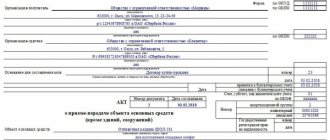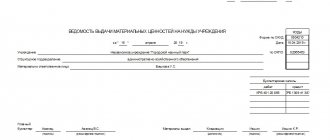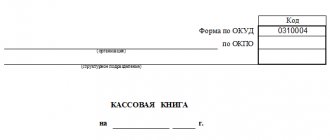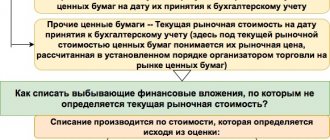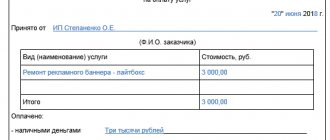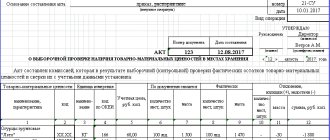Rules and example of filling out the act of writing off a car OS-4a
To write off vehicles from the enterprise’s register, a unified form OS-4a “Act on the write-off of motor vehicles” is provided.
This form applies exclusively to transport. If you need to write off any other fixed asset item, you should use the OS-4 form, a sample of which can be downloaded here. How is the OS-4a write-off act filled out? At the end of the article we offer a sample of filling out the OS-4a form for writing off a passenger car.
The reason for writing off a car may be a breakdown that cannot be repaired, physical or moral wear and tear. When a vehicle is in a condition that is no longer usable, it should be written off. The car is assessed by a commission. It is she who concludes that the transport cannot be repaired. The manager issues an order to write off the object, a sample of which can be downloaded here. The commission fills out the act in form OS-4a in two copies. The first is transferred to the accountant responsible for accounting for fixed assets. The second remains with the financially responsible person.
Main form parameters
The need to fill out form OS-4a arises when writing off vehicles operated for commercial purposes and for the benefit of the organization. It should be taken into account that this form is designed only for registering the write-off of vehicles; the main objects of the enterprise are subject to write-off on the basis of another form of Act No. OS-4.
Reasons for deregistering a vehicle may include:
- breakdowns that cannot be repaired;
- fatal defects;
- the fact that the enterprise is unable to use the funds due to its theft.
To correctly draw up a report on the write-off of vehicles, you will need to prepare complete information about the object:
- car release date;
- date of commissioning;
- date of receipt of the vehicle at the enterprise and its registration;
- dates of deregistration with the traffic police;
- time of the last major overhaul;
- vehicle mileage (full and after last repair);
- initial cost (or replacement cost after repair);
- cost minus depreciation.
In addition to general information about the car, you need to prepare more detailed information:
- information about the engine number, chassis;
- technical passport data;
- load capacity and capacity;
- weight according to the technical passport;
If there are precious metals in the car's design, they are indicated separately (type, weight, quantity, etc.). Acceptance for registration of components dismantled from a vehicle is indicated in a separate section of the form.
Form of the act on write-off of motor vehicles:
Sample of drawing up an act on the write-off of an OS-4a car
Filling out the title page:
- Name of organization and division;
- Act number and date;
- Name and make of the vehicle;
- Reason for write-off;
- Factory, registration and inventory number of the vehicle;
- Full name and position of the responsible person.
1. Information as of the write-off date
1 – year of production of vehicles;
2 – date of commissioning;
3 – date of acceptance for accounting;
4 – date of the last major overhaul, if carried out;
5 – date of deregistration with the State Traffic Safety Inspectorate (all vehicles are subject to registration with the State Traffic Safety Inspectorate, therefore, when deregistering an object, it must be deregistered and receive a document confirming this deregistration, the document is attached to the completed decommissioning act OS-4a);
6 – mileage since the beginning of operation;
7 – mileage since the last major overhaul.
2. Information about the value as of the date of write-off
1 – initial or replacement cost. The replacement cost is indicated for a car whose value has been revalued.
2 – depreciation on transport from the beginning of operation.
3 – difference between columns 1 and 2.
3. Characteristics of the object
1 – serial number;
2,3,4 – numbers of the technical passport for the vehicle, number on the engine and chassis;
5 – carrying capacity and capacity of the vehicle according to the passport;
6 – weight of the vehicle according to the passport;
7-11 – maintenance of jewelry.
Conclusion of the commission: the commission assessing the condition of the car writes here information about the future fate of the object, about the need to write off the vehicle.
4. Information on acceptance of dismantled parts for accounting
The vehicle may contain parts and components suitable for further use. Such details should be taken into account.
1,2,3 – part numbers;
4 – part name;
5 – its unit of measurement;
7 – unit price;
8 – cost of capitalized parts remaining after dismantling the vehicle.
5. Information on the costs of decommissioning vehicles and revenues after dismantling.
1 – type of work associated with the decommissioning and dismantling of the facility;
2 – document on the basis of which the work was carried out;
3.4 – correspondent accounts reflecting the operation to perform the work.
5 – the amount of costs for the work performed;
6 – document on the basis of which dismantled parts are accepted for accounting;
7 – name of receipts;
8 – item number;
9 – unit of measurement;
10 – number of capitalized parts;
11.12 – unit price and total cost of parts accepted for accounting after the car is written off;
13, 14 – wiring corresponding to the acceptance of vehicle parts for registration.
Line by line filling algorithm
Using a sample when filling out will allow you to quickly and competently draw up a document, which in the future will become the basis for the disposal of an object from the enterprise and the completion of accounting entries.
Information about the correct entry format will allow you to correctly and consistently enter information into each line of the form:
- year of manufacture (indicate the year indicated in the registration certificate for the vehicle);
- commissioning (enter the month and year of the start of use of the product);
- total mileage since the start of operation and mileage after major repairs (indicated in km);
- the initial cost is entered with information taken from account 01;
- data about the vehicle (identification number of the vehicle and its elements is taken from the technical passport);
- load capacity is expressed in kg;
- vehicle capacity – in people;
- vehicle weight - from the information in the technical passport.
The final part contains the commission’s conclusions: the vehicle must be written off due to a specific reason. Before writing a conclusion, members of the commission must inspect the vehicle and determine the possibility/impossibility of further restoration or repair. Further in the text of the conclusion there is an indication of exactly how the write-off should be carried out.
Defective statements, operating manuals, documents for deregistration with the traffic police, technical passport and other documents must be listed as appendices to the act.
The fourth table contains information about units and parts that can be delivered to the enterprise after dismantling work.
The information in this section is presented:
- part or assembly numbers;
- part name;
- in what units is it measured?
- number of units delivered to the arrival;
- the price of each unit and the total amount.
The fifth table contains information about the types of write-off work, correspondent accounts for cost accounting, the amount of expenses, the number, date of the document that became the basis for registration, a list of assets accepted for registration, indicating the item number (their quantity, price, amount, name), correspondent account transactions accepted for accounting.
After completion of deregistration activities, a corresponding mark is placed on the inventory cards.
An example of filling out a vehicle write-off report:
Who draws up an act for writing off car funds?
This document is prepared by a specialist from the accounting department. This is due to the fact that any write-off of fixed assets of an enterprise is subject to accounting and tax accounting. However, in order to first certify the reasons for writing off a vehicle, a special commission is created in the organization. The order for its formation is issued by the head. It must include a specialized specialist (mechanic, driver, etc.), as well as employees of other structural divisions.
After the commission concludes that it is impossible to further use the vehicle, a write-off report is drawn up.
As a rule, in large enterprises all actions of the commission are subject to a specific, strictly established algorithm.
Sample car write-off
Contents If you need to create a car inspection report, but you don’t know how to correctly prepare this document, look at the sample given here and its analysis - with their help, with minimal edits, you will be able to draw up the required form without much difficulty.
The example under consideration concerns the inspection of a car by transport company employees.
- If necessary, you can supplement the document with other data that you consider important.
- Next, in the main part, indicate the identification parameters of the car: its make, state license. number, year of manufacture, color and anything else you see fit.
- First of all, enter the name of the organization into the document, then assign a number to the document (taking into account the internal document flow of the enterprise), indicate the date and place of its execution.
- The document must be signed by all persons who were present during the inspection.
- After this, enter in the form the composition of the commission that carried out the inspection: positions and full names of employees.
- Then include the inspection details: they can be quite general or as detailed as possible (describing the condition of each element of the car).
- If any damage or breakdowns were identified during the procedure, be sure to include information about them in the report form, indicating, if possible, the reason for their occurrence. In conclusion, give a conclusion about the general technical condition of the vehicle, as well as the possibility of its further operation.
If equipment defects are detected during its installation and commissioning, as well as during the process of checking the quality of fixed assets, based on the results of the inventory, a report on the identified equipment defects is drawn up (Resolution of the State Statistics Committee of the Russian Federation dated January 21, 2003 N 7).
Based on the results of the inspection of defective equipment, the expert commission issues a conclusion either on the need to repair this equipment, or on the impossibility of eliminating the defects. If the defects cannot be corrected, then an equipment write-off act is drawn up (clause 29 of section V of PBU 6/01, approved by Order of the Ministry of Finance of Russia dated March 30, 2001 N 26n)
Basic rules for drawing up an act on write-off of auto funds
This document does not have a unified template that is mandatory for use, so each enterprise has the right to independently develop its own template for the act or write it in free form. The main requirement is that it must contain information about the company on whose balance sheet the vehicle being written off is listed, as well as detailed information about the write-off object. In addition, the document must have the signatures of all members of the commission and the approving autograph of the head of the enterprise. In the future, the fact of write-off must be reflected in the inventory documentation.
It is customary to create a write-off act in one copy, which is transferred to the organization’s accounting department.
Registration of write-off of fixed assets
The procedure for writing off fixed assets is envisaged only in certain situations, but regardless of the reason, a certain procedure must be followed. The movement of any types of property between several structures of the organization does not apply to disposal and does not provide for the possibility of writing off funds. In the same way, there is no write-off when the use of any property is completed due to the need for installation or reconstruction.
Rules for drawing up an order
The order is the basis for the further work of the authorized members of the commission, and it is stipulated that this commission will be engaged in conducting special inspections and assessing the condition of the property, as well as determining the possibility and feasibility of carrying out restoration work in relation to this object. Only after this are the reasons why further liquidation of this property may be carried out.
All components that will subsequently be used as separate elements in the organization’s business activities must be identified.
If experts have confirmed the unsuitability of the operating facility, management will be required to issue a separate order, according to which authorized persons will be able to liquidate fixed assets with the correct execution of the necessary documentation.
Instructions for filling out the write-off act
- At the beginning of the document, you need to enter information about the company that owns the vehicle: its name indicating its organizational and legal status.
- Then enter the document number for internal document flow, as well as the date of its preparation.
- The sign on the right indicates the position, last name, first name, patronymic of the manager , who, after drawing up the act, will approve it.
- Next comes information related to the vehicle : its model and numbers (factory, inventory, registration).
- The reason for the write-off and the persons bearing financial responsibility, if any, are also indicated here
First table
Below in the document is the first table, where the date of release and commissioning, the date of acceptance for accounting in this company, as well as information about the last capital are entered. repairs, deregistration with the traffic police and everything related to mileage.
Second table
The second table relates to the financial part - here you need to indicate the price of the car at the time it was registered, the amount of depreciation from the beginning of its use and the residual value (i.e. the difference between the initial price and accrued depreciation).
Third table
It contains a brief description of the object.
- All information about the vehicle being written off is reflected here (taken from the vehicle’s passport), including the presence of drag. metals
- Below, in special lines about other characteristics, you can enter any other necessary information about the car (at the discretion of the owner).
- Next, the commission enters into the document its conclusion on the need for write-off , and also indicates the documents attached to the act. Then all members of the commission certify the act with their signatures .
Sample
When drawing up an act, it is important to reliably reflect the information and provide a complete description of both the objects being written off and their quantitative values: volume, cost.
The form consists of a text and tabular part, represented by the following parameters:
- group serial number;
- name of objects indicating distinctive characteristics;
- inventory number;
- actual service life;
- the cost of objects upon arrival or after restoration;
- accrued depreciation;
- residual value;
- information about the presence of precious metals in write-off items.
On the reverse side of the form, the commission draws up its conclusion on the exhaustion of the strength resource, making a decision on the further inexpediency of using the funds indicated in the tabular part and the impossibility of taking measures for further restoration for operation in the interests of the company.
Physical wear and tear is most often cited as the cause. At the end of the conclusion, a responsible employee is appointed who will carry out dismantling or liquidation, as well as further actions with the decommissioned objects.
After the conclusion, a description of the documents attached to the act on the liquidation of groups of objects is provided.
Below the conclusion, the form contains another tabular part, which contains information about all materials remaining after write-off that arose during the write-off process (liquidation and dismantling). The table reflects the fact of receipt of financial assets formed after write-off.
Examples of reasons for disposal of an asset
The reasons for writing off a fixed asset can be varied.
The main reasons for disposal are:
- the main tool is outdated,
- the object was subject to improper operation,
- The OS is damaged as a result of accidents, natural disasters or fire,
- the operating time of the facility has been completed and under other similar circumstances.
What to write in the line “write-off results”
The line about the results of the write-off indicates the monetary value of the loss as a result of the deregistration of the fixed asset. Let’s say “the loss is two thousand rubles.”
Download free form and sample in word
conclusions
Several main points can be highlighted on this topic:
- To write off fixed assets, the company must draw up a corresponding act.
- The form can be drawn up in free form. However, there is a unified form OS-4.
- The act must contain three blocks: information about the condition of the object being written off, its characteristics and information about costs.
- The document is drawn up by a specially created commission, approved by order of the director of the enterprise.
- The act can be drawn up by hand or printed on a computer. The signatures, however, must all be living.
- A document is drawn up in the amount of two pieces.
- The act must indicate the reason for writing off the company’s property, that is, the fact that it is unsuitable for use.
- When written off, the amount of loss for the enterprise in monetary terms is reflected in a separate line of the act.
Completing section 2
The section of the write-off act is filled out if the object contains precious stones and metals. The data can be taken from the transfer and acceptance certificate.
Here the commission’s conclusion on the need for write-off is written and the signatures of all commission members are affixed.
Completing section 3:
A list of costs associated with decommissioning an object, its dismantling and disassembly is provided.
1 – type of work performed.
2 – number and date of the document on the basis of which the work is carried out.
3 – the amount of costs for this work.
4, 5 – numbers of corresponding accounts for cost accounting.
Here is a list of proceeds from write-off, for example, parts remaining after dismantling can be capitalized as material assets.
Write-off results: loss or profit from write-off, determined as the difference between costs and revenues.
The write-off of a fixed asset is noted in the inventory card of the object: form OS-6, OS-6a or OS-6b.
Rules for filling out the act of writing off motor vehicles, form OS-4a - form and sample
Sooner or later, any company property must be written off. The need to carry out a procedure of this nature arises in a situation where fixed assets cease to generate income.
The process of writing off fixed assets requires the execution of special papers, the main of which is the corresponding act.
The article describes typical situations. To solve your problem , write to our consultant or call for free:
+7 — Moscow — CALL
+7 — St. Petersburg — CALL
+8 ext.849 — Other regions — CALL
It's fast and free!
The need to compile
Drawing up a write-off act is required when there is a need to deregister fixed assets from the balance sheet of the enterprise.
The latter includes almost any property of the company expressed in non-monetary form.
It is important to note that to write off vehicles, you should use a special form - OS-4a.
The document is drawn up in several copies. One remains with the warehouse employees, the other is transferred to the accounting department to make changes to the relevant accounting.
Form OS-4a is used in a situation in which the car becomes unusable. It is important to note that this form applies only if the OS is a motor vehicle.
For the rest of the property, another sample act is used - form OS-4 or OS-4b.
The need to create a special unified form is due to the presence of a significant number of characteristics of vehicles. Among these it should be noted:
- data on deregistration with the traffic police;
- information about vehicle mileage;
- information about the details of the object, its numbers, etc.
Comment on the rating
Thank you, your rating has been taken into account. You can also leave a comment on your rating.
Is the sample document useful?
If the document “Act for rejection and write-off of a car (car trailer) (in relation to standard form No. os-4a)” was useful to you, we ask you to leave a review about it.
Remember just 2 words:
Contract-Lawyer
And add Contract-Yurist.Ru to your bookmarks (Ctrl+D).
You will still need it!
Who does it?
The act, drawn up in the OS-4a form, is filled out by the specialist responsible for carrying out such actions.
In this case, this could be an employee of the accounting department.
This necessity is due to the fact that any actions that are carried out with fixed assets must be reflected in accounting and tax accounting.
It is important to note that before a vehicle is written off, a special commission is created. It must include at least 3 people. The purpose of its creation is to determine the need to write off the car and assess its condition.
The formation of the commission occurs after the issuance of a corresponding order issued by the head of the company.
Only after the members of the commission conclude that it is necessary to write off the vehicle, an act of the unified form OS-4a is drawn up.
Upon completion of the assessment of the condition of motor vehicle property, members of the commission draw up a special conclusion, which displays information about the results obtained.
It is transferred to the management of the company. Situations may arise in which members of the commission have doubts about the need to write off motor vehicle property. Such problems are solved by company leaders.
Leave a comment on the document
Do you think the document is incorrect? Leave a comment and we will correct the shortcomings. Without a comment, the rating will not be taken into account!
Thank you, your rating has been taken into account. The quality of documents will increase from your activity.
| Here you can leave a comment on the document “Act for rejection and write-off of a car (car trailer) (in relation to standard form No. os-4a)”, as well as ask questions associated with it. If you would like to leave a comment with a rating , then you need to rate the document at the top of the page Reply for |

